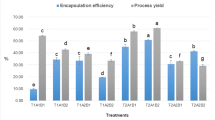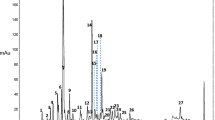Abstract
The study aims to recover bioactive compounds, as well as sugar, from pineapple waste extract (PWE) using spray-drying technology. Maltodextrin is used as encapsulating agent combined with PWE at inlet temperature of 100 °C, 110 °C, 120 °C and 130 °C. The spray-drying process of PWE was repeated at 100 °C inlet temperature using two other carrier agents: gum arabic and starch, to compare its solubility. The total polyphenol content (TPC) in powder samples is significantly reduced by 33%, from 27 to 18 mg/g, as the maltodextrin concentration is increased from 2.5 to 10% (p < 0.05). On the other hand, the ferric-reducing antioxidant power of PWE powders is insignificantly affected by the increase in MD content (p > 0.05). Furthermore, the proteolytic enzyme activity in PWE powders significantly increases, from ~ 5 to ~ 9 U/mL, as the MD content is increased from 2.5 to 10% (p < 0.05). The TPC in powder samples significantly decreases from 29 to 22 mg/g as inlet temperature is increased from 100 to 120 °C (p < 0.05). There is also a significant decrease in polyphenol retention, which is about 21%. The protease enzyme activity in PWE powders significantly decreases as the inlet temperature of spray dryer is increased (p < 0.05). It is observed that starch has the lowest retention among the encapsulating agents. The results show that maltodextrin concentration and inlet temperature significantly affected the polyphenol, sugar content and the enzyme activity. The antioxidant capacity of the powders was not affected by both parameters.



Similar content being viewed by others
References
Aliakbarian, B., Paini, M., Alberto, A.: Effect of encapsulating agent on physical-chemical characteristics of olive pomace polyphenols-rich extracts. Chem. Eng. Trans. (2015). https://doi.org/10.1080/00224499.2014.976781
Alias, N.H., Abbas, Z.: Preliminary investigation on the total phenolic content and antioxidant activity of pineapple wastes via microwave-assisted extraction at fixed microwave power. Chem. Eng. Trans. (2017). https://doi.org/10.3303/CET1756280
American Public Health Association—APHA.: Standard Methods for Examination of Water and Wastewater. American Public Health Association, Washington, DC (2005)
AOAC. (2012). AOAC International Methods Committee Guidelines for Validation of Microbiological Methods for Food and Environmental Surfaces. AOAC Official Methods of Analysis. AOAC, Gaithersburg
Bhattacherjee, A.K., Tandon, D.K., Dikshit, A.: Antioxidant activity and quality of spray dried aonla powder as affected by storage behavior of juice. J. Sci. Ind. Res. 73(09), 607–612 (2014)
Bisharat, G.I., Lazou, A.E., Panagiotou, N.M., Krokida, M.K., Maroulis, Z.B.: Antioxidant potential and quality characteristics of vegetable-enriched corn-based extruded snacks. J. Food Sci. Technol. (2015). https://doi.org/10.1007/s13197-014-1519-z
Brien, S., Lewith, G., Walker, A., Hicks, S.M., Middleton, D.: Bromelain as a treatment for osteoarthritis: a review of clinical studies. Evid. Based Complement. Altern. Med. (2004). https://doi.org/10.1093/ecam/neh035
Caliskan, G., Dirim, S.N.: The effects of the different drying conditions and the amounts of maltodextrin addition during spray drying of sumac extract. Food Bioprod. Process. (2013). https://doi.org/10.1016/j.fbp.2013.06.004
Chaurasiya, R.S., Umesh Hebbar, H.: Extraction of bromelain from pineapple core and purification by RME and precipitation methods. Sep. Purif. Technol. (2013). https://doi.org/10.1016/j.seppur.2013.03.029
Chobotova, K., Vernallis, A.B., Majid, F.A.A.: Bromelain’s activity and potential as an anti-cancer agent: current evidence and perspectives. Cancer Lett. (2010). https://doi.org/10.1016/j.canlet.2009.08.001
Conesa, C., Seguí, L., Laguarda-Miró, N., Fito, P.: Microwaves as a pretreatment for enhancing enzymatic hydrolysis of pineapple industrial waste for bioethanol production. Food Bioprod. Process. 100, 203–213 (2016). https://doi.org/10.1016/j.fbp.2016.07.001
Costa-Silva, T.A., Souza, C.R.F., Oliveira, W.P., Said, S.: Characterization and spray drying of lipase produced by the endophytic fungus Cercospora kikuchii. Braz. J. Chem. Eng. (2014). https://doi.org/10.1590/0104-6632.20140314s00002880
Cupp-Enyard, C.: Sigma’s non-specific protease activity assay-casein as a substrate. J. Vis. Exp. (2008). https://doi.org/10.3791/899
D’Archivio, M., Filesi, C., Di Benedetto, R., Gargiulo, R., Giovannini, C., Masella, R.: Polyphenols, dietary sources and bioavailability. Ann. Ist Super. Sanita 43(4), 348–361 (2007)
Datta, C., Dutta, A., Dutta, D., Chaudhuri, S.: Adsorption of polyphenols from ginger rhizomes on an anion exchange resin Amberlite IR-400—study on effect of pH and temperature. Procedia Food Sci. (2011). https://doi.org/10.1016/j.profoo.2011.09.135
Deng, G.F., Shen, C., Xu, X.R., Kuang, R.D., Guo, Y.J., Zeng, L.S., et al.: Potential of fruit wastes as natural resources of bioactive compounds. Int. J. Mol. Sci. (2012). https://doi.org/10.3390/ijms13078308
Dziedzic, S.Z., Kearsley, M.W.: Handbook of Starch Hydrolysis Products and their Derivatives. Springer, New York. (1995). https://doi.org/10.1007/978-1-4615-2159-4
Elridge, J.A., Repko, D., Mumper, R.J.: Retention of polyphenolic species in spray-dried blackberry extract using mannitol as a thermoprotectanttle. J. Med. Food 17, 1064–1069 (2014)
Fang, Z., Bhandari, B.: Effect of spray drying and storage on the stability of bayberry polyphenols. Food Chem. (2011). https://doi.org/10.1016/j.foodchem.2011.05.093
Georgetti, S.R., Casagrande, R., Souza, C.R.F., Oliveira, W.P., Fonseca, M.J.V.: Spray drying of the soybean extract: effects on chemical properties and antioxidant activity. LWT Food Sci. Technol. (2008). https://doi.org/10.1016/j.lwt.2007.09.001
Gomez, F., Pablos, M.: Pineapple waste extract for preventing oxidation in model food systems. J. Food Sci. (2016). https://doi.org/10.1111/1750-3841.13341
Hemalatha, R., Anbuselvi, S.: Physicohemical constituents of pineapple pulp and waste. J. Chem. Pharm. Res. 5(2), 240–242 (2013)
Hossain, M.A., Rahman, S.M.M.: Total phenolics, flavonoids and antioxidant activity of tropical fruit pineapple. Food Res. Int. (2011). https://doi.org/10.1016/j.foodres.2010.11.036
Huang, K., Zhang, P., Hu, B., Yu, S.: The effect of spray drying on sucrose-glycine caramel powder preparation. J. Sci. Food Agric. 96, 2319–2327 (2016)
Ignat, I., Volf, I., Popa, V.I.: A critical review of methods for characterisation of polyphenolic compounds in fruits and vegetables. Food Chem. (2011). https://doi.org/10.1016/j.foodchem.2010.12.026
Ketnawa, S., Chaiwut, P., Rawdkuen, S.: Pineapple wastes: a potential source for bromelain extraction. Food Bioprod. Process. (2012). https://doi.org/10.1016/j.fbp.2011.12.006
Kha, T.C., Nguyen, M.H., Roach, P.D.: Effects of spray drying conditions on the physicochemical and antioxidant properties of the Gac (Momordica cochinchinensis) fruit aril powder. J. Food Eng. (2010). https://doi.org/10.1016/j.jfoodeng.2010.01.016
Kuppusamy, S., Thavamani, P., Megharaj, M., Naidu, R.: Bioremediation potential of natural polyphenol rich green wastes: a review of current research and recommendations for future directions. Environ. Technol. Innov. (2015). https://doi.org/10.1016/j.eti.2015.04.001
Maurer, H.R.: Bromelain: biochemistry, pharmacology and medical use. Cell. Mol. Life Sci. (2001). https://doi.org/10.1007/PL00000936
Medina, J.D., Garcia, H.S.: Pineapple post-harvest operations. Instituto Technologico de Veracruz. Veracruz City, Mexico (2005)
Mishra, P., Mishra, S., Mahanta, C.L.: Effect of maltodextrin concentration and inlet temperature during spray drying on physicochemical and antioxidant properties of amla (Emblica officinalis) juice powder. Food Bioprod. Process. (2014). https://doi.org/10.1016/j.fbp.2013.08.003
Mong Thu, T.T., Krasaekoopt, W.: Encapsulation of protease from Aspergillus oryzae and lipase from Thermomyces lanuginoseus using alginate and different copolymer types. Agric. Nat. Resour. (2016). https://doi.org/10.1016/j.anres.2016.06.002
Munin, A., Edwards-Lévy, F.: Encapsulation of natural polyphenolic compounds; a review. Pharmaceutics. (2011). https://doi.org/10.3390/pharmaceutics3040793
Murad, H.: Method of treating dermatological disorders by fruit extracts. US Patent No 6,630,163 B1. USA (2003)
Namaldi, A., Çalik, P., Uludag, Y.: Effects of spray drying temperature and additives on the stability of serine alkaline protease powders. Dry. Technol. (2006). https://doi.org/10.1080/07373930600961108
Nielsen, S.S.: Phenol-sulfuric acid method for total carbohydrates. In: Nielsen, S.S. (eds.), Food Science Texts Series. Springer, Boston (2010)
Pandey, R.K., Manimehalai, N.: Production of instant tea powder by spray drying. Int. J. Agric. Food Sci. Technol. 5, 197–202 (2014)
Pang, S.F., Yusoff, M.M., Gimbun, J.: Assessment of phenolic compounds stability and retention during spray drying of Orthosiphon stamineus extracts. Food Hydrocoll. (2014). https://doi.org/10.1016/j.foodhyd.2013.10.022
PSA.: Major fruit crops quarterly bulletin. PSA, Manila (2018)
Rashad, M.M., Mahmoud, A.E., Ali, M.M., Nooman, M.U., Al-Kashef, A.S.: Antioxidant and anticancer agents produced from pineapple waste by solid state fermentation. Int. J. Toxicol. Pharmacol. Res. (2015). https://doi.org/10.1002/anie.200902762
Robert, P., Gorena, T., Romero, N., Sepulveda, E., Chavez, J., Saenz, C.: Encapsulation of polyphenols and anthocyanins from pomegranate (Punica granatum) by spray drying. Int. J. Food Sci. Technol. (2010). https://doi.org/10.1111/j.1365-2621.2010.02270.x
Roda, A., Lucini, L., Torchio, F., Dordoni, R., De Faveri, D.M., Lambri, M.: Metabolite profiling and volatiles of pineapple wine and vinegar obtained from pineapple waste. Food Chem. (2017). https://doi.org/10.1016/j.foodchem.2017.02.111
Rudra, S.G., Jakhar, N., Kaur, C., Nishad, J.: Food industry waste: mine of nutraceuticals. Int. J. Sci. Environ. Technol. 4(1), 205–229 (2015)
Saénz, C., Tapia, S., Chávez, J., Robert, P.: Microencapsulation by spray drying of bioactive compounds from cactus pear (Opuntia ficus-indica). Food Chem. (2009). https://doi.org/10.1016/j.foodchem.2008.09.095
Saraswaty, V., Risdian, C., Primadona, I., Andriyani, R., Andayani, D.G.S., Mozef, T.: Pineapple peel wastes as a potential source of antioxidant compounds. In: IOP Conference Series: Earth and Environmental Science. (2017). https://doi.org/10.1088/1755-1315/60/1/012013
Seguí, L., Fito, P.: An integrated approach for pineapple waste valorisation. Bioethanol production and bromelain extraction from pineapple residues. J. Clean. Prod. 172, 1224–1231 (2018). https://doi.org/10.1016/j.jclepro.2017.10.284
Sengupta, S., Dasgupta, M.: Industrial and clinical applications excluding diagnostic clinical enzymology. Enzymology, 1–22 (2006)
Shishir, M.R.I., Chen, W.: Trends of spray drying: a critical review on drying of fruit and vegetable juices. Trends Food Sci. Technol. (2017). https://doi.org/10.1016/j.tifs.2017.05.006
Simeon, L.: Philippine fruit production grows 4% in quarter 2 2018. The Philippine Star, p. https://www.philstar.com/business/agriculture/2018 (2018)
Siti Roha, A.M., Zainal, S., Noriham, A., Nadzirah, K.Z.: Determination of sugar content in pineapple waste variety N36. Int. Food Res. J. (2013). https://doi.org/10.1021/jp037756f
Soares, P.A.G., Vaz, A.F.M., Correia, M.T.S., Pessoa, A., Carneiro-Da-Cunha, M.G.: Purification of bromelain from pineapple wastes by ethanol precipitation. Sep. Purif. Technol. (2012). https://doi.org/10.1016/j.seppur.2012.06.042
Sukeksi, L., Sarah, M.: Characterizations and extraction of polyphenols from residual pulp of pink guava as source of antioxidants. ARPN J. Eng. Appl. Sci. 11, 5209–5216 (2016)
Sulaiman, S.F., Yusoff, N.A.M., Eldeen, I.M., Seow, E.M., Sajak, A.A.B., Supriatno, Ooi, K.L.: Correlation between total phenolic and mineral contents with antioxidant activity of eight Malaysian bananas (Musa sp.). J. Food Compos. Anal. (2011). https://doi.org/10.1016/j.jfca.2010.04.005
Sun-Waterhouse, D., Wadhwa, S.S., Waterhouse, G.I.N.: Spray-drying microencapsulation of polyphenol bioactives: a comparative study using different natural fibre polymers as encapsulants. Food Bioprocess Technol. (2013). https://doi.org/10.1007/s11947-012-0946-y
Tang, W.-Q., Li, D.-C., Lv, Y.-X., Jiang, J.-G.: Concentration and drying of tea polyphenols extracted from green tea using molecular distillation and spray drying. Dry. Technol. (2011). https://doi.org/10.1080/07373937.2010.516851
Terpinc, P., Čeh, B., Ulrih, N.P., Abramovič, H.: Studies of the correlation between antioxidant properties and the total phenolic content of different oil cake extracts. Ind. Crops Prod. (2012). https://doi.org/10.1016/j.indcrop.2012.02.023
Thomson, A.B., Keelan, M., Thiesen, A., Clandinin, M.T., Ropeleski, M., Wild, G.E.: Small bowel review: normal physiology part 1. Dig. Dis. Sci. 46(12):2567–2587 (2001)
Tochi, B.N., Wang, Z., Xu, S.Y., Zhang, W.: Therapeutic application of pineapple protease (Bromelain): a review. Pak. J. Nutr. (2008). https://doi.org/10.3923/pjn.2008.513.520
Tonon, R.V., Brabet, C., Hubinger, M.D.: Anthocyanin stability and antioxidant activity of spray-dried açai (Euterpe oleracea Mart.) juice produced with different carrier agents. Food Res. Int. (2010). https://doi.org/10.1016/j.foodres.2009.12.013
Tunchaiyaphum, S., Eshtiaghi, M.N., Yoswathana, N.: Extraction of bioactive compounds from mango peels using green technology. Int. J. Chem. Eng. Appl. (2013). https://doi.org/10.7763/IJCEA.2013.V4.293
Upadhyay, A., Lama, J.P., Tawata, S.: Utilization of pineapple waste: a review. J. Food Sci. Technol. Nepal. (2013). https://doi.org/10.3126/jfstn.v6i0.8255
Vieira, F.G.K., Borges, G.D.S.C., Copetti, C., Di Pietro, P.F., Nunes, E., da Costa, E., & Fett, R.: Phenolic compounds and antioxidant activity of the apple flesh and peel of eleven cultivars grown in Brazil. Sci. Hortic. (2011). https://doi.org/10.1016/j.scienta.2011.01.032
Volf, I., Ignat, I., Neamtu, M., Popa, V.I.: Thermal stability, antioxidant activity, and photo-oxidation of natural polyphenols. Chem. Pap. (2014). https://doi.org/10.2478/s11696-013-0417-6
Wolfe, K., Wu, X., Liu, R.H.: Antioxidant activity of apple peels. J. Agric. Food Chem. (2003). https://doi.org/10.1021/jf020782a
Acknowledgements
We would like to thank the various pineapple farms for supporting us in this study. We would also like to thank Department of Science and Technology Engineering Research and Development for Technology, Philippines for giving us the opportunity to do our research and Green Environment Management Systems Incorporated together with Chemical Engineering Laboratory Department of University of San Carlos for letting us use the facilities and equipment for the experiment.
Author information
Authors and Affiliations
Corresponding author
Additional information
Publisher’s Note
Springer Nature remains neutral with regard to jurisdictional claims in published maps and institutional affiliations.
Rights and permissions
About this article
Cite this article
de Ramos, R.M.Q., Siacor, F.D.C. & Taboada, E.B. Effect of Maltodextrin Content and Inlet Temperature on the Powder Qualities of Spray-Dried Pineapple (Ananas comosus) Waste Extract. Waste Biomass Valor 11, 3247–3255 (2020). https://doi.org/10.1007/s12649-019-00651-8
Received:
Accepted:
Published:
Issue Date:
DOI: https://doi.org/10.1007/s12649-019-00651-8




